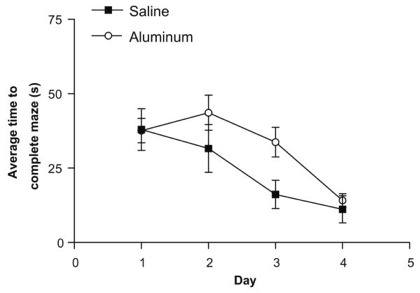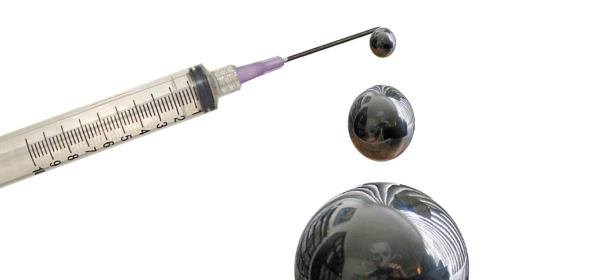by Heidi Stevenson
Gaia-Health.com
This is the second Keele Conference report. Aluminum is used as an adjuvant in many vaccines, but it’s a known neurotoxin. Dr. Christopher Shaw has been doing research on its effects, demonstrating that it crosses the blood-brain barrier, that it is strongly associated with autism, & that it has adverse effects on lab animals. Does it meet the cause-and-effect standard?
What most stands out about the Annual Keele Meeting on Aluminium is that it’s full of scientists who’ve chosen to follow where the science leads, rather than going where the money is. They have my undying admiration, and I hope, as these articles from the conference come out, they’ll have yours, too. One whom I felt particularly honored to meet is Christopher Shaw, who is one of the two leaders in the science on aluminum used in vaccine adjuvants—along with Romain Gherardi, who also presented at Keele, and whose work will also be covered.
Shaw reported on the latest research out of his lab, Neural Dynamics Research Group, which has found that mice exposed to more aluminum adjuvant delivered according to the current vaccine schedule suffered from more harmful neurological effects. He provided an abstract of the latest project1, and delivered a talk about the work his lab and others have done that now make the case that aluminum adjuvants are causing a great deal of harm.
Using a slide show, Shaw started with this definitive statement:
Administration of aluminum in vaccine-relevant exposures in neonatal mice is associated with long-term adverse neurological outcomes.
Notice that there’s no hedging. Shaw definitively stated that aluminum in vaccines is associated with severe harm to young mice—and he went on to document it. He covered these topics:
-
Aluminum as a neurotoxin.
-
Aluminum as an adjuvant in vaccines.
-
The in vivo data.
-
Aluminum in vaccines and autism spectrum disorder (ASD).
-
Connecting pediatric vaccines with aluminum.
-
Where we go from here?
Aluminum as a Neurotoxin
Aluminum has been noted as a neurotoxin for over a century. Back in 1911, Dr. William Gies wrote:
These studies have convinced me that the use in food of aluminum or any other aluminum compound is a dangerous practice. That the aluminum ion is very toxic is well known. That aluminized food yields soluble aluminum compounds to gastric juice (and stomach contents) has been demonstrated. That such soluble aluminum is in part absorbed and carried to all parts of the body by the blood can no longer be doubted. That the organism can ‘tolerate’ such treatment without suffering harmful consequences has not been shown. It is believed that the facts in this paper will give emphasis to my conviction that aluminum should be excluded from food.2
It has long been known that aluminum is toxic when eaten. By extension, it isn’t a stretch to imagine that it must also be toxic when injected, and very possibly even more so.
Aluminum is known to be involved in the following:
- Impairment of memory, cognition, and psychomotor control.
- Impairment of neurotransmission and synaptic activity.
- Interference with the blood-brain barrier.
- Acting as a pro-oxidant.
- Activating microglia and brain inflammation.
- Depressing brain glucose metabolism.
- Impairing transcription.
- Promoting neurite damage.
- Promoting amyloidosis.
- Possibly activating autoimmune reactions.
People are exposed to aluminum in a wide range of ways, including medications, vaccines, food, water, cosmetics, health products, and industrial activities. Exposure is ubiquitous in today’s world.
Aluminum as an Adjuvant in Vaccines
The first journal reference to aluminum as an adjuvant in vaccines was “The antigenic value of toxoid precipitated by potassium alum.” published in the Journal of Pathology & Bacteriology in 1926. Now it’s licensed for about two-thirds of the routine childhood vaccines, many of which are given multiple times:
Shaw reviewed several studies on different aspects of aluminum as a vaccine adjuvant. These are listed in Sources below. He and his team have clearly demonstrated that young mature male mice, aged 1-3 months, injected with aluminum adjuvant in doses comparable to those given human children is associated with neurological damage.
The in Vivo Data
Neurological tests performed on young mature male lab mice injected with aluminum adjuvants in amounts equivalent to that given in human vaccinations demonstrated significant losses in neurological functions. In one experiment, the mice were injected with an aluminum adjuvant, a squalene adjuvant, a combination aluminum-squalene adjuvant, or a saline control. These graphs describe the results:
In the first graph, you can see the results of a wire mesh hang. In this experiment, mice are hung upside-down as they hold onto a wire mesh. The time until they are no longer able to hold and drop off is measured. Notice that all three adjuvants had a definitive effect on their ability to hold onto the mesh, and that the mice injected with the aluminum adjuvant alone were most limited in the length of time they could hold on.
In the second graph, you see the results of an open field test. In that trial, the young mature male mice are rated on how much time they’re willing to spend in an open area, rather than an apparently safe enclosed one. As in the wire mesh hang, you can see that there’s a significant difference in the mice given an adjuvant, and that the aluminum-adjuvanted mice are the least adventurous.
Last are the results of the water maze test. This trial tests for how many errors a mouse makes in learning to solve a maze. It’s a test of memory. They were put through the maze several times, and as you can see, they make significantly more errors as a result of injection with an aluminum adjuvant.
 A simpler graph showing the distinction in amount of time can be seen to the right. Before injection on day 1, you can see that the average time to solve the maze is the same. However, after injection with aluminum, you can see how significantly the mice’s memory was damaged. In spite of having gone through the maze once already, it took them longer the second time, after injection.
A simpler graph showing the distinction in amount of time can be seen to the right. Before injection on day 1, you can see that the average time to solve the maze is the same. However, after injection with aluminum, you can see how significantly the mice’s memory was damaged. In spite of having gone through the maze once already, it took them longer the second time, after injection.
Morin labeling is a test that was used to identify the presence of aluminum in the spinal cord of these mice. The result of this test, shown above, clearly demonstrates that aluminum enters the lumbar spinal cord. Image A shows no sign of aluminum in the controls. The bright green spots in image B show the presence of aluminum in the aluminum-treated mice. To the right are the same results displayed in a graph. It also includes the squalene and aluminum+squalene injected mice.
Inflammation
The existence of aluminum sequestered in the body as a result of aluminum adjuvants is, by itself, not an indication that there’s a problem. However, if inflammation is demonstrated to exist, then there’s reason for concern. The mice in this experiment showed distinct signs of inflammation in various places in the spinal cord as a result of being injected with an aluminum adjuvant.
Continued on Page 2 with a focus on Autism.
Read the full article here: http://gaia-health.com/gaia-blog/2013-03-26/current-status-of-aluminum-adjuvant-research
Sources:
Sources referenced by Shaw in his talk:
- Some Objections to the Use of Alum Baking Powder, JAMA; William J. Gies, Ph.D; doi:10.1001/jama.1911.04260090038015
- Aluminum Vaccine Adjuvants: Are They Safe?, Journal of Inorganic Biochemisty; L. Tomljenovic and C.A. Shaw; doi:10.1016/j.jinorgbio.2009.05.019.
- Aluminum hydroxide injections lead to motor deficits and motor neuron degeneration; Journal of Inorganic Biochemisty; Christopher A. Shaw and Michael S. Petrik; 10.1016/j.jinorgbio.2009.05.019
- Aluminum Adjuvant Linked to Gulf War Illness Induces Motor Neuron Death in Mice; Neuromolecular Medicine. 2007;9(1):83-100; Petrik MS, Wong MC, Tabata RC, Garry RF, Shaw CA
- Aluminum-based adjuvants should not be used as placebos in clinical trials, Vaccine; Exley, C; doi: 10.1016/j.vaccine.2011.08.062
- A role for the body burden of aluminium in vaccine-associated macrophagic myofasciitis and chronic fatigue syndrome; Medical Hypotheses; Exley C, Swarbrick L, Gherardi RK, Authier FJ; doi: 10.1016/j.mehy
- ‘ASIA’—Autoimmune/inflammatory syndrome induced by adjuvants, Journal of Autoimmunity; Shoenfeld Y, Agmon-Levin N.; doi: 10.1016/j.jaut.2010.07.003
- Long-term persistence of vaccine-derived aluminum hydroxide is associated with chronic cognitive dysfunction, Journal of Inorganic Biochemistry; Couette M, Boisse MF, Maison P, Brugieres P, Cesaro P, Chevalier X, Gherardi RK, Bachoud-Levi AC, Authier FJ; doi: 10.1016/j.jinorgbio.2009.08.005
- Do aluminum vaccine adjuvants contribute to the rising prevalence of autism? Journal of Inorganic Biochemistry; Lucija Tomljenovic and Christopher A. Shaw; doi:10.1016/j.jinorgbio.2011.08.008
- Empirical Data Confirm Autism Symptoms Linked to Aluminum and Acetaminophen Exposure, Journal of Inorganic Biochemistry; Stephanie Seneff, Robert M. Davidson, and Jingjing Liu; doi:10.3390/e14112227
- Mechanisms of aluminum adjuvant toxicity and autoimmunity in pediatric populations; Journal of Inorganic Biology; Tomljenovic, L, Shaw, CA; doi: 10.1177/0961203311430221
Vaccine Epidemic
by Louise Kuo Habakus and Mary Holland J.D.
FREE Shipping Available!






